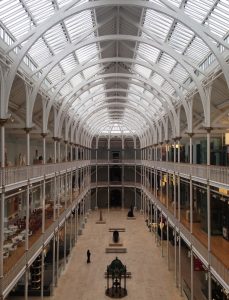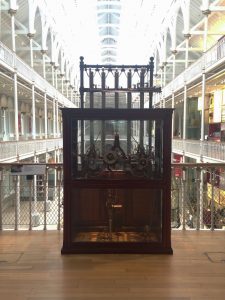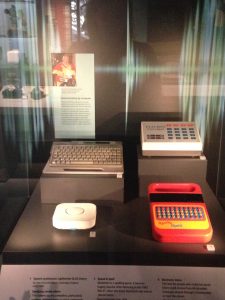
The national museum of Scotland in Edinburgh, UK, hosts six different collections departments. I had the honour of being toured through two of the galleries by the keepers of those collections: the Science and Technology gallery, with Dr. Sam Alberti and the Art and Design gallery, with Xavier Dectot.

The science and technology gallery was full of airplanes, 3D printers, assembly machines, old machinery, communication, etc. Ceramics, furniture, fabrics, fashion and jewellery found their place in the arts and design galleries. Giving a little bit of insight into how these boundaries were created, the two keepers mocked each others expenses on “silly things” like “a pair of shoes” and “dysfunctional technology” while touring us around the objects. Where in some cases the distinction between what is technology and what is design was clear, the keepers also came across parts of the collection that were less easily categorised. Clocks, for example, where a point of debate, and these ended up being not only conceptually but also physically placed in between the galleries.

Seeing these things struggle to find their place raises a discussion on what objects’ role in a museum is. Here too, the two keepers disagreed. Sam Alberti was clear: museums, by taking once functioning objects out of their context, kill things. This “if you love something, set it free” approach to things in museums was countered by Xavier Dectot, who argued that museums provide objects a second or a longer life. As an observer, the mix of historical things and things that I know and lived with made me aware of the many different ways an object can exist in a chain of actors. Obviously for a designer, an engineer or an artist, a thing has different value than for a user, for a museum collector and again, for a museum visitor. Seeing these familiar things on display behind glass indeed felt a little silly. Of course there are the practical concerns of keeping all these things functioning, but it does raise the question whether we, and future audiences, can really experience the essence of a thing when it is switched off in isolation. Museums in way present the empty shells of things, but they do so lovingly, to tell the stories of the objects that once could speak for themselves.
Add yours Comments – 1
This is fantastic! What a great opportunity to join curators in the act of debating their own categories and classifications. Your post highlights the role of classification systems in knowledge production, and the role of the curator as an arbiter of that knowledge. I wish we all could have joined you–thank you for the post.